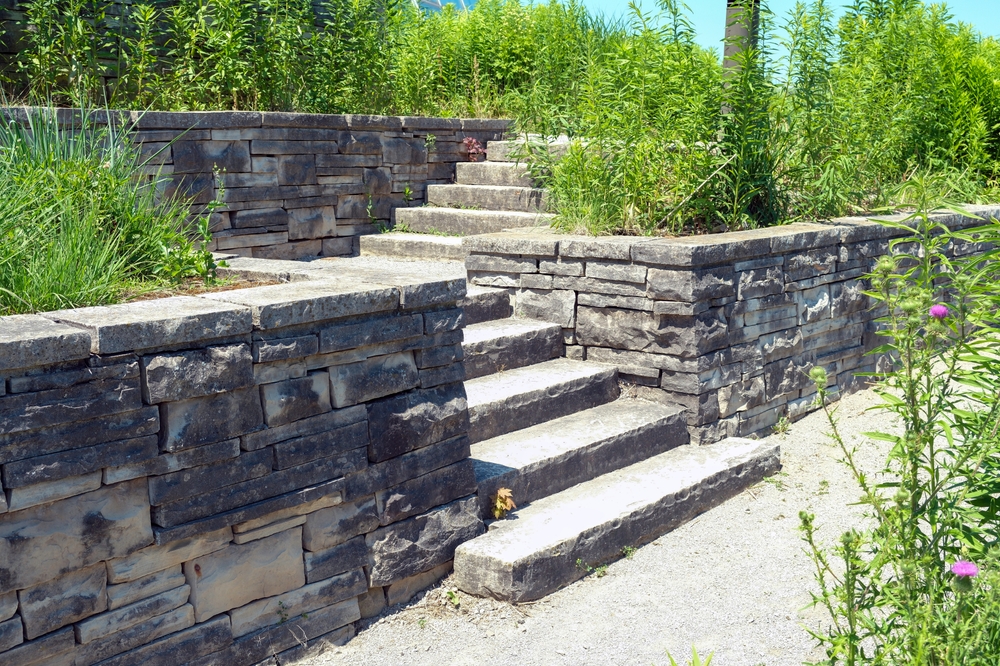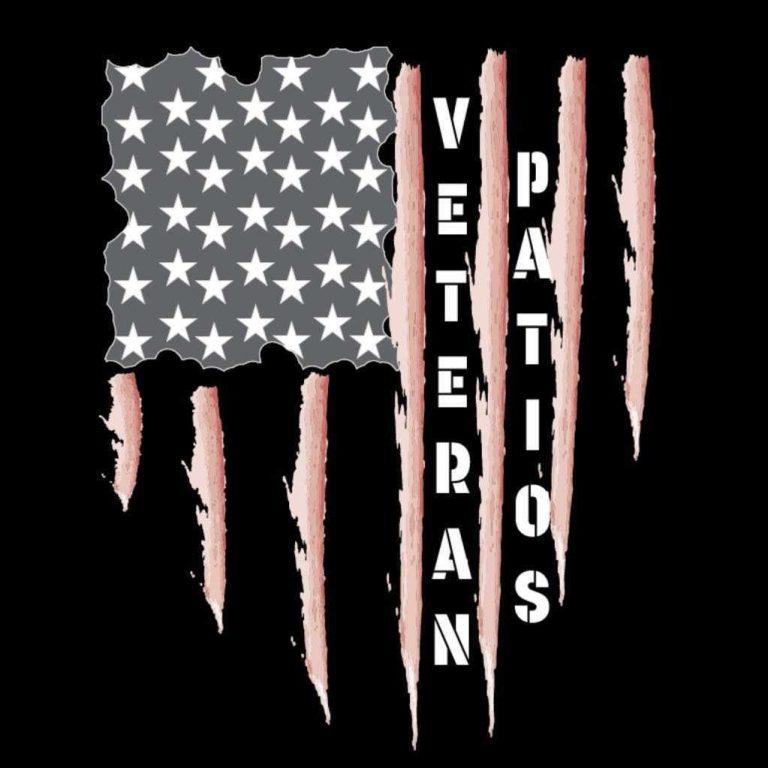
Key Takeaways:
- Proper drainage is critical for retaining wall longevity – Without effective water management, hydrostatic pressure can cause even expertly built walls to bow, crack, or collapse
- Multi-component drainage systems are essential – Graduated backfill materials, perforated drainage pipes, weep holes, and filter fabric work together to redirect water and prevent pressure buildup
- Colorado’s climate creates unique challenges – Rapid snowmelt, intense storms, soil shrinkage, and freeze-thaw cycles demand robust drainage systems designed for extreme weather events
- Common drainage mistakes lead to costly failures – Using clay backfill, insufficient pipe slope, missing filter fabric, and poor surface grading create water retention that destroys retaining walls prematurely
Retaining walls are more than just structural elements in a landscape. They provide both aesthetic appeal and essential functionality, particularly in sloped terrains. While the beauty of natural stone, concrete blocks, or timber may captivate homeowners, what truly determines the longevity of a retaining wall lies beneath the surface. Proper drainage is the unsung hero that ensures these walls remain sturdy and unyielding, standing tall through the test of time and the elements.
At Veteran Patios, with over 15 years of experience transforming outdoor spaces in the Denver Metro Area, we’ve seen firsthand how critical drainage is. Neglecting this foundational element leads to costly repairs and sometimes total wall collapse. Colorado’s fluctuating climate, characterized by heavy rainfall, rapid snowmelt, and freeze-thaw cycles, only heightens the need for effective drainage systems in retaining walls.
Understanding Hydrostatic Pressure and Its Threat to Retaining Walls
One of the most significant threats to the integrity of a retaining wall is hydrostatic pressure. This force occurs when water builds up in the soil behind the wall. While water might seem harmless, it exerts tremendous force, approximately 60 pounds per cubic foot, continuously pressing against the structure. Without a well-designed drainage system, this pressure can force even expertly constructed walls to bow, crack, or collapse entirely.
Many Denver homeowners overlook the role of soil type in drainage needs. Colorado’s soils range from sandy loams to dense clays. Clay soils, in particular, are highly problematic. Unlike sandy soils that drain quickly, clay retains water, expanding and contracting with moisture changes. This movement exerts constant stress on retaining walls, gradually compromising their strength over time. Understanding these soil conditions is paramount to designing a drainage system capable of mitigating these forces.
The Anatomy of a Well-Drained Retaining Wall
A lasting retaining wall depends on several crucial drainage components. At Veteran Patios, we prioritize every detail to ensure your wall performs optimally in all conditions.
The Role of Backfill Materials
Backfill is the material placed behind the retaining wall, and it plays a vital role in promoting proper drainage. Native soil is unsuitable for this purpose as it tends to retain water. Instead, we employ a graduated backfill system designed to maximize drainage efficiency and prevent soil migration:
The area directly behind the wall is filled with clean, angular 3/4″ gravel, providing a drainage zone where water can flow freely downward without building up pressure. Beyond this zone, we transition to a mix of gravel and soil, creating a stabilized barrier. Finally, the outer zone is compacted native soil, amended to suit specific site conditions.
For walls exceeding four feet in height, multiple drainage zones with progressively finer materials are incorporated. This ensures consistent drainage while adding an extra layer of structural support.
Incorporating Drainage Pipes
Drainage pipes are essential for capturing and redirecting water away from the wall. Without this system, water collects at the base, dramatically increasing hydrostatic pressure. Our installations typically include a perforated 4-inch PVC drain pipe, placed strategically at the base of the wall. The pipe is wrapped in filter fabric to prevent clogging, ensuring consistent performance over time.
We ensure the pipe is installed with a minimum slope of 1% to steer water away effectively. Depending on the site’s layout, drainage outlets are positioned every 25 to 50 feet to redirect water safely. For situations where gravity drainage isn’t feasible, we employ collection basins and pumps to actively remove water, preserving the wall’s integrity.
Weep Holes for Additional Support
Solid retaining walls, such as those made from concrete or mortared stone, require weep holes to allow accumulated water to escape. Without these openings, water would become trapped, particularly in winter, where freezing temperatures could lead to ice expansion and potential wall damage.
We strategically place weep holes every four to six feet, especially at the wall’s lowest points, where water is most likely to collect. For taller walls, holes are arranged in a staggered pattern, ensuring efficient water drainage across all areas.
The Importance of Geotextile Filter Fabric
Filter fabric is an often-overlooked component, yet it plays a crucial role in maintaining the longevity of drainage systems. This material separates gravel from surrounding soil, preventing fine particles from clogging drainage pathways. Proper application of filter fabric ensures water freely flows while keeping the drainage zone intact for years to come. The fabric’s weight and type are carefully selected based on soil conditions to optimize its performance without restricting water flow.
Common Retaining Wall Drainage Mistakes
After repairing numerous failed retaining walls across Denver, we’ve pinpointed common drainage mistakes that lead to premature wall failure. Poor backfill choices, such as using clay soil directly behind the wall, create a dam effect, trapping water instead of allowing it to drain. Insufficient or improperly sloped drainage pipes, missing filter fabric, and inadequate outlet planning exacerbate these issues. Additionally, surface grading that channels water toward the wall, rather than away from it, compounds drainage struggles.
Addressing Denver’s Unique Climate Challenges
Colorado’s climate demands extra consideration when designing retaining walls. Rapid snowmelt in spring, intense summer thunderstorms, dry months causing soil shrinkage, and freeze-thaw cycles all place unique strains on landscape structures. Drainage systems must be robust enough to handle both ordinary moisture levels and extreme weather events. Larger-capacity drainage setups, tailored specifically to Denver’s climate conditions, are a hallmark of our design process.
Maintenance Ensures Long-Term Performance
Even the most well-designed drainage systems require ongoing maintenance to perform their best. Regular inspection is key to identifying and addressing potential issues early. Clearing drainage outlets of debris, monitoring for signs of erosion, and inspecting for wet spots are simple steps that go a long way in preserving your retaining wall. At Veteran Patios, we also offer maintenance services to ensure your wall remains in top condition.
Drainage Is the Best Foundation for a Lasting Wall
Investing in proper drainage may increase upfront costs, but the payoff is invaluable. Walls equipped with comprehensive drainage solutions can last decades, standing firm against the forces of nature. At Veteran Patios, we bring over 15 years of expertise to each project, ensuring no detail is overlooked.
Are you planning a retaining wall project? Don’t hesitate to reach out to our specialists for expert guidance. Contact Veteran Patios today for a consultation and discover how we can create a durable, beautiful retaining wall tailored to Denver’s unique landscape conditions.

FAQs About Retaining Wall Drainage
1. Why is proper drainage important for retaining walls?
Proper drainage prevents hydrostatic pressure, which can cause walls to bow, crack, or collapse. Without effective water management, even expertly built walls are at risk of failure.
2. What components make up a good drainage system for retaining walls?
A multi-component system includes graduated backfill materials, perforated drainage pipes, weep holes, and geotextile filter fabric. These elements work together to redirect water and prevent pressure buildup.
3. How does Colorado’s climate affect retaining wall drainage?
Colorado’s freeze-thaw cycles, rapid snowmelt, and intense storms create unique challenges. Robust drainage systems are essential to handle these extreme weather conditions and protect the wall’s integrity.
4. What are common drainage mistakes to avoid?
Using clay backfill, insufficient pipe slope, missing filter fabric, and poor surface grading are common errors. These mistakes trap water, leading to premature wall failure.
5. How can I maintain my retaining wall’s drainage system?
Regularly inspect and clear drainage outlets, monitor for erosion or wet spots, and ensure filter fabric and pipes remain unclogged. Routine maintenance preserves the wall’s longevity and performance.
